Poverty and Income Inequality in Scotland 2011/12
Statistics on the percentage and number of children, working age adults and pensioners living in low income households in Scotland, and the distribution of household income across Scotland.
This document is part of a collection
Chapter 2: Poverty
Low Income Poverty Indicators
The Scottish Government currently uses two main indicators of low income poverty, both of which reveal slightly different information about changes in poverty over time. These indicators are relative and absolute poverty.
Relative poverty:
Individuals living in households whose equivalised income is below 60% of UK median income in the same year. This is a measure of whether those in the lowest income households are keeping pace with the growth of incomes in the population as a whole. In 2011/12 the relative poverty threshold for a couple with no children was an income of £256 per week (BHC) from all sources (see Annex 2 for further information on income definitions). For a couple with children the threshold would be higher and for a single person (without children) the threshold would be lower.
Absolute poverty:
Individuals living in households whose equivalised income is below 60% of the (inflation adjusted) median income in 2010/11. This is a measure of whether those in the lowest income households are seeing their incomes rise in real terms. In 2011/12 the absolute poverty threshold for a couple with no children was an income of £264 per week (BHC) from all sources (see Annex 2 for further information on income definitions).
Change of reference year for absolute poverty:
For the 2005/06 to 2010/11 publications, absolute poverty was measured against 60% of median household income in 1998/99 adjusted for inflation. In order to keep the absolute low income measure in line with the Child Poverty Act 2010, the reference year for measuring absolute low income has been changed to 2010/11, adjusted for inflation to 2011/12 prices. The change in the reference year has a large effect on the percentage and number of people identified as in absolute poverty. It also magnifies the scale of historical changes in the time series. This is because the threshold has moved to a more densely populated part of the income distribution (see Annex 3 for further information on the effects of the change in reference year). This affects absolute poverty measurement for all groups in this publication.
2.1 Individuals in poverty
The Scottish Government's National Indicator 35 is to "reduce the proportion of individuals living in poverty": http://www.scotland.gov.uk/About/Performance/scotPerforms/indicator/poverty
This is measured using relative poverty before housing costs. Charts 1a and 1b below show Scottish trends for relative and absolute poverty between 1998/99 and 2011/12.
Chart 1a: Relative Poverty - All individuals: 1998/99 - 2011/12
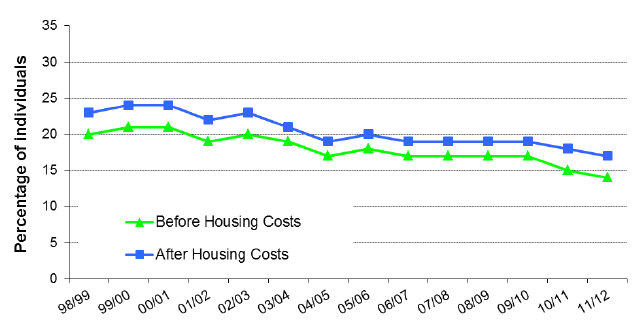
Chart 1b: Absolute Poverty - All individuals: 1998/99 - 2011/12

Source: HBAI dataset, DWP. See Annex 1 (Tables A1 and A2) for the figures behind these charts.
Charts with confidence intervals for relative and absolute poverty can be found in Confidence Intervals Surrounding Key Poverty Estimates
Main points:
- In 2011/12, there were 710 thousand people (14 per cent of the population) in relative poverty (BHC) and 780 thousand people (15 per cent of the population) in absolute poverty (BHC) in Scotland.
- Between 2010/11 and 2011/12, the percentage of people in relative poverty (BHC) did not change significantly (15% in 2010/11 to 14% in 2011/12). There has been no significant change in the number of people in relative poverty (BHC) since 2006/07.
- Between 2010/11 and 2011/12, the percentage of people in absolute poverty (BHC) remained at 15 per cent. There has been no significant change in absolute poverty since 2006/07.
- For a reduction in the number of individuals living in households in absolute poverty over the period, incomes at the lower end of the income distribution in 2010/11 would have had to increase by more than inflation. Instead, household incomes of low income households increased by about the same level as inflation, meaning there was no statistically significant change in absolute poverty levels in 2011/12.
- Between 2002/03 and 2004/05, relative and absolute poverty rates fell in Scotland. Before 2002/03, absolute poverty was considerably higher than relative poverty. Absolute poverty rates remained broadly the same from 2004/05. As absolute poverty is now based on 2010/11 income, the two measures are identical for the 2010/11 year.
2.2 Child poverty
Child poverty is commonly measured using the following indicators:
- relative poverty,
- absolute poverty,
- material deprivation and low income combined.
These are three of the four poverty indicators which the UK parliament is required to report on by the 2010 Child Poverty Act. There is also a persistent poverty indicator in the Act but the precise target is yet to be defined. Information on the targets for the Child Poverty Act can be found in Annex 1.
The Scottish Government's National Indicator 36 is to "reduce children's deprivation": http://www.scotland.gov.uk/About/Performance/scotPerforms/indicator/childdeprivation
This is measured using the material deprivation and low income combined poverty indicator.
Material Deprivation and Low Income Combined Poverty Indicator:
Material deprivation is calculated from a suite of questions in the Family Resources Survey about whether people can afford to buy certain items and participate in leisure or social activities. This measure is applied to households with incomes below 70% of UK median income (£299 per week) to create the 'material deprivation and low income combined' indicator. This indicator aims to provide a measure of children's living standards which, unlike relative and absolute poverty, is not solely based on income.
Changes to measuring material deprivation in 2011/12:
The 21 items in the suite of questions used to measure material deprivation are designed to reflect the items and activities people in the UK believe to be necessary. These items are reviewed periodically to ensure the measure remains a relative measure of poverty. In 2010/11 four new items were included in the FRS, and in 2011/12 four old items were removed. Both sets of questions were asked in 2010/11 to allow an overlap for comparison. This creates a break in the child material deprivation series, with the measure for 2004/05 to 2010/11 on the old basis. The new measure is presented for 2010/11 and 2011/12 (see Annex 2 for further detail).
Chart 2 below presents recent Scottish poverty trends for these three child poverty indicators.
Chart 2: Child Poverty in Scotland: 1998/99 - 2011/12
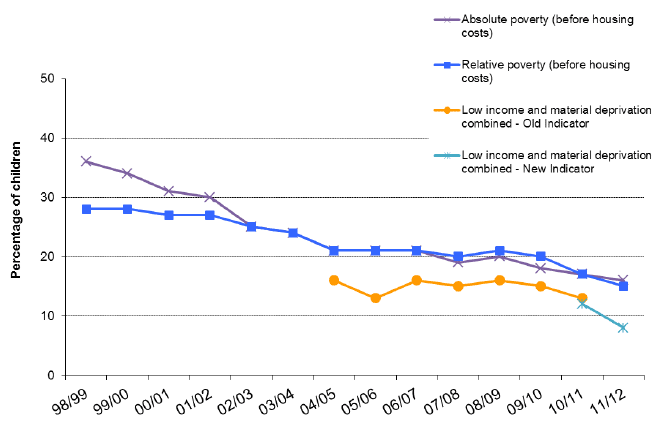
Source: HBAI dataset, DWP. See Annex 1 (Tables A1, A2 and A3) for the figures behind these charts.
Note: A version of this chart showing the Child Poverty Act targets can be found in Annex 1, Chart A10. Charts with confidence intervals for relative and absolute child poverty can be found in Confidence Intervals Surrounding Key Poverty Estimates.
Main points:
- The percentage of children in relative poverty (BHC) decreased from 17 per cent to 15 per cent in 2011/12, a reduction of 20 thousand children. In 2011/12 there were 150 thousand children living in relative poverty (BHC). The change between 2010/11 and 2011/12 is not statistically significant.
- The percentage of children in absolute poverty (BHC) in 2011/12 was 16 per cent, a decrease from 17 per cent in 2010/11. This represents 160 thousand children living in absolute poverty (BHC) in 2011/12, a decrease of 10 thousand from 2010/11. Again, the change from 2010/11 is not statistically significant.
- The percentage of children in material deprivation and low income combined decreased from 12 per cent to 8 per cent, a reduction of 40 thousand children to 80 thousand in 2011/12. For this measure the low income threshold is defined as 70% of UK median income.
- The measurement of child material deprivation is based on self-perceived ability to afford the 21 items and activities identified as 'necessary'. This measure is applied to households with incomes below 70% of UK median income. In 2011/12, the number of households with children identified as low income decreased, and within this the percentage who were identified as materially deprived fell.
- Families with children in the lower income deciles generally receive a greater percentage of their income from benefits and a smaller percentage from earnings than households just containing working age adults.
- The percentage of children living in absolute poverty decreased from 1998/99 to 2004/05 and then remained relatively unchanged until 2008/09. Between 2008/09 and 2011/12 there has been a small decrease in absolute child poverty levels, however the rate of decrease was slower compared to the overall rate of decrease observed between 1998/99 and 2004/05.
2.3 Working age adult poverty
Working age vs. State pension age:
Working age adults are defined as all adults up to the State pension Age. Prior to April 6th 2010, women reached the state pension age at 60. From 6th April 2010, the qualifying age for women has been gradually increasing. The changes do not affect the state pension age for men, which remains at 65. As with the analysis for 2010/11, the age groups covered by the analysis for working age adults and pensioners in 2011/12 will change to reflect these shifts in the qualifying age for state pensions for women. The impact is to retain women in the working age adult group, who prior to April 2010 would have been classified as pensioners.
Charts 3a and 3b below present recent relative and absolute poverty trends for working age people in Scotland.
Chart 3a: Relative Poverty: 1998/99 - 2011/12
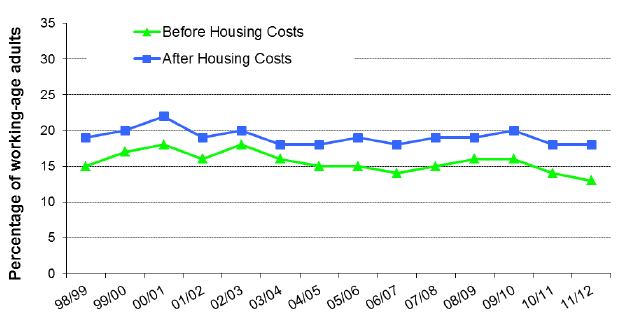
Chart 3b: Absolute Poverty: 1998/99 - 2011/12
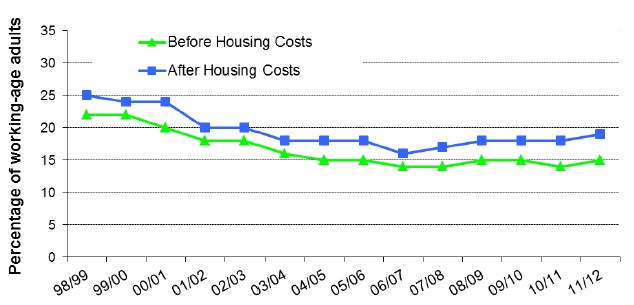
Source: HBAI dataset, DWP. These figures are also presented in Annex 1 (Tables A1 and A2).
Charts with confidence intervals for relative and absolute working age adult poverty can be found in Confidence Intervals Surrounding Key Poverty Estimates
Main points:
- In 2011/12, 420 thousand working age adults were living in relative poverty (BHC), a decrease of 20 thousand from 2010/11.
- The percentage of working age adults in relative poverty (BHC) was 13 per cent in 2011/12, down from 14 per cent in 2010/11. This change is not statistically significant.
- The percentage of working age adults in relative poverty (AHC) remained the same as in 2010/11 (18 per cent).
- The percentage in absolute poverty (both BHC and AHC) increased by one percentage point between 2010/11 and 2011/12. Neither change was statistically significant.
- The percentage of working age adults in absolute poverty (BHC) has remained largely unchanged since 2004/05, following a significant decrease between 1998/99 and 2003/04. The percentage of working adults in absolute poverty (AHC) also recorded a significant decrease between 1998/99 and 2003/04, with rates remaining largely unchanged since then.
- The percentage of working age adults in relative poverty (BHC) recorded a small increase between 1998/99 and 2002/03, remaining largely unchanged until 2009/10. There has been a small decrease to 13 per cent (from 16 per cent) since 2009/10. Overall, the trend is broadly flat.
- The percentage of working age adults in relative poverty (AHC) has remained largely unchanged since 2003/04, following a decrease between 1998/99 and 2002/03.
2.4 Pensioner poverty
Pensioner Material Deprivation Indicator:
This is an additional way to measure the living standards of pensioners. This measure is based on a set of goods, services and experiences, judged using academic research to be the best discriminators of deprivation. Pensioners are asked if they have an item (or access to a service) and to give a reason if they do not have it. Their responses are then used to judge whether or not they are materially deprived. It is similar to the child material deprivation and low income combined indicator (which is presented in Chart 2) but has some important differences:
- Differences in the set of items asked about, e.g. pensioners are not asked if they can afford school trips.
- Pensioners are presented with a greater variety of reasons for not having a particular item, whereas families with children are simply asked whether they can afford an item they do not have. Pensioners are able to say if they are prevented from having it due to ill health, disability or lack of support from other people. These additions reflect that deprivation can occur because of ill health, disability or social isolation, and not just for financial reasons.
- The pensioner "material deprivation" indicator is not combined with household income information to produce a combined indicator, as is done with the child deprivation indicator. This is because for pensioners, the concept of material deprivation is broad and very different from low income, so it is appropriate to present it as a separate measure.
For these reasons, pensioner material deprivation cannot be directly compared to the child material deprivation and low income measure.
More background on pensioner material deprivation is given in Annex 2, and the following technical note on the DWP website gives further information, including the list of questions which are asked to pensioners: http://research.dwp.gov.uk/asd/hbai/technical_note_20110307.pdf
State pension age:
Working age adults are defined as all adults up to the State pension Age. Prior to April 6th 2010, women reached the state pension age at 60. From 6th April 2010, the qualifying age for women has been gradually increasing. The changes do not affect the state pension age for men, which remains at 65. The age groups covered by the analysis for working age adults and pensioners in 2011/12 changed to reflect these changes in the qualifying age for state pensions for women. The impact is to retain women in the working age adult group, who prior to April 2010 would have been classified as pensioners.
However material deprivation is presented here for pensioners aged 65 and over only.
Charts 4a and 4b present recent trends for the three main pensioner poverty indicators: relative poverty, absolute poverty and the material deprivation indicator. Note that poverty based on income after housing costs is a more commonly used measure for pensioner households, as many have low housing costs. Further discussion on whether it is better to use before or after housing costs can be found in the Introduction.
Chart 4a: Relative Poverty: 1998/99 - 2011/12
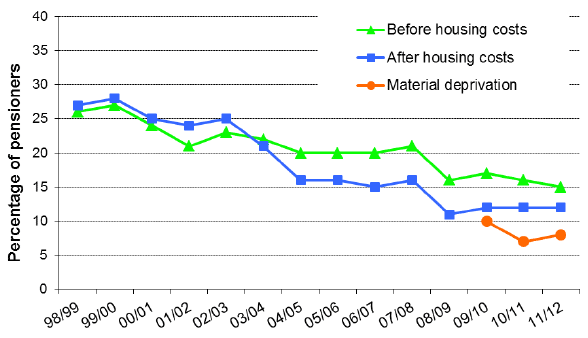
Chart 4b: Absolute Poverty: 1998/99 - 2011/12
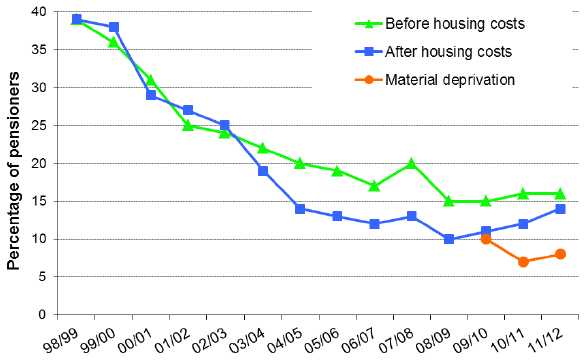
Source: HBAI dataset, DWP. These figures are also presented in Annex 1 (Tables A1 and A2 and A4).
Charts with confidence intervals for relative and absolute pensioner poverty can be found in Confidence Intervals Surrounding Key Poverty Estimates.
Notes:
1. Pensioner material deprivation is not solely based on affordability and so should not be compared directly with measures of income-related poverty.
2. Pensioner material deprivation is included for those aged 65 and over only and therefore is not the same population as relative and absolute poverty measures.
Main points:
- In 2011/12, there were 140 thousand pensioners living in relative poverty (BHC), a decrease of 20 thousand from 2010/11.
- The percentage of pensioners in relative poverty (BHC) in 2011/12 was 15 per cent, compared with 16 per cent in 2010/11. This has remained relatively unchanged since 2008/09.
- The changes in the latest year in the relative pensioner poverty rates were small and not statistically significant.
- The percentage of pensioners living in relative poverty (AHC) was 12 per cent in 2011/12, unchanged from 2010/11. This percentage has remained largely unchanged since 2008/09, following a significant decrease in pensioner poverty between 1998/99 and 2004/05. There was a decrease between 2004/05 and 2008/09, but at a slower rate.
- There were 150 thousand pensioners living in absolute poverty (BHC) in 2011/12, a decrease of 10 thousand from 2010/11. This represents 16 per cent of pensioners, unchanged from 2010/11. This percentage has remained largely unchanged over the last four years, following a decrease in 2008/09.
- Eight per cent of pensioners aged 65 and over were materially deprived in 2011/12, compared to 7 per cent in 2010/11. In 2009/10, 10 per cent of pensioners were living in material deprivation.
- The fall in pensioner poverty since 1998/99 has been steeper than comparable falls for children and working age adults.
- Households containing pensioners at the lower end of the income distribution generally received a larger proportion of their income from benefits and a smaller proportion from other sources. So because benefit income grew more than earned income, households with pensioners saw their overall income fall less in real terms in 2011/12 than other households with more income from earnings. In addition, many benefits and tax credit elements were uprated in 2011/12 by 3.1 per cent, the annual increase in the CPI to September 2010. However the Basic State Pension increased by 4.6 per cent, while Pension Credit Guarantee Credit was increased by the cash rise in the full Basic State Pension, an increase of 3.6 per cent.
2.5 In-work poverty
In-work poverty:
'In-work poverty' refers to those individuals living in households where at least one member of the household is working (either full or part time) but where the household income is below the poverty threshold. This group contains non-working household members such as children and non-working partners.
Chart 5 compares recent Scottish in-work poverty trends with the relative poverty trends.
Chart 5: Proportion of individuals in in-work poverty (relative poverty before housing costs): 1998/99 - 2011/12
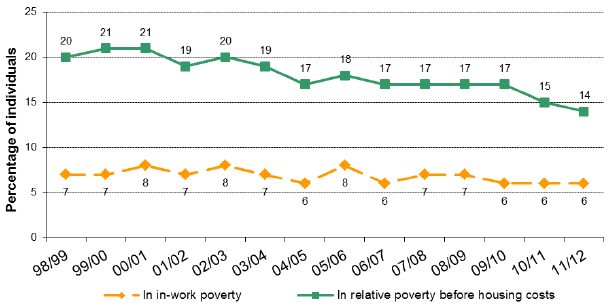
Source: HBAI dataset, DWP. These figures are also presented in Annex 1 (Table A5).
Main points:
- During 2011/12, 6 per cent of people in Scotland were in relative in-work poverty, the same as 2010/11 and 2009/10.
- In 2011/12, this represents 280 thousand people living in households in relative poverty (BHC), despite the fact that these households contain a working member.
- In-work poverty trends have remained flat over the years since 1998/99, at between 6 and 8 per cent of the population.
Contact
Email: Stephen Smith
There is a problem
Thanks for your feedback